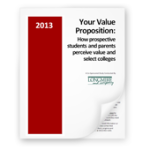Many people, when shopping to buy a home, will look at several very similar houses – in similar neighborhoods with features that are very much alike – and this makes sense because most people have some idea of what they want and then start looking.
But often, even though the houses are so similar, the decision comes easy, because there is just something about that one home that says “this is it.” And the “it” can be highly individualized.

Why do the “buyers” (applicants/students) get EXCITED about your college? And why should you spend some time figuring this out? The data from our recent co-sponsored study “Your Value Proposition: How prospective students and parents perceive value and select colleges” gave us some very valuable insight into excitement and the role it plays in enrollment.
About 75 percent of those surveyed in the study said they would reconsider a college they initially thought was too expensive if the college could demonstrate greater value.
Interesting, right? But what really got our attention were the answers to the second part of that question, when students and parents told us what value a college could offer to make the investment worthwhile. Those answers, it turned out, showed that there is a distinct disconnect between what colleges think applicants value and what applicants actually value.
And all of this is very important, or should be, to college enrollment and marketing managers, because what students value is also what gets them excited about your college. And excitement is what gets students enrolled and in the seats.
We addressed this concept of excitement and how important it is in a recent blog post. Briefly, to recap, we discussed how perceived value has three components: quality, cost and excitement about attending. All are important, but all do not have equal weight in the college decision process. Excitement about attending is most strongly related to likelihood of enrollment. Get students excited and you will likely have them as your students.
So back to this idea of what, exactly will get students excited and how it is so crucial to know what to communicate to potential students.
Colleges might spend a lot of time and effort, for example, telling applicants and families that their four-year graduation rate is exemplary and job and graduate school placement rates are very high. But most of the time, we found, students do not get emotional about outcomes. It is something else. And emotions drive decisions.
Longmire and Company recently conducted several focus groups on college campuses to explore this issue of when and how the emotional commitment to a specific college occurs. Students were able to tell us the exact moment in time that the light went on for them and they knew a specific college was right for them. They were able to tell us their surroundings, the people they were with, the time of day, the weather, what was happening, what was said, who said it, and many other things in startling detail. It was a moment in time frozen in their memory.
Listening and watching these students recall their experiences in the focus groups was fascinating. And highly instructive. It revealed that much of what we are doing to generate student excitement is, in fact, not doing so at all. Further, some of the things we do actually turn prospective students off and we don’t even know it.
Finding out what your prospective students find exciting is so important, we believe, you absolutely must take the time and effort to extract this from them. Then use what you learn to talk up a variety of values through every communications channel, painting a clear and broad picture of who you are and putting students in the environment to experience it firsthand.
We’ve discussed this before, but it bears repeating because it is so important: enrollment managers must take a student-centric approach to recruiting and know that it isn’t about the college, it is about the student. Ask students what they value – what will get them excited about your school – in your personal conversations with them. Tell them how your college offers what they value, build their excitement about attending.
We work frequently with colleges, helping admissions professionals change their focus to the student, in our Interactive Training Workshops. This training is invaluable to many colleges in re-tooling their recruitment processes so that students get the information and experiences that truly interest and excite them. We are more than happy to share our process with you. Just give us a call at (913) 492-1265.
 More than 80 percent of the students and parents said they would find it appealing (47 percent said “very appealing”). They see it as a value added service that makes a college more attractive.
More than 80 percent of the students and parents said they would find it appealing (47 percent said “very appealing”). They see it as a value added service that makes a college more attractive. The perceived value that a student attaches to your institution correlates strongly with his or her likelihood of enrollment. Perceived value has three components: perceived quality, cost and excitement about attending. A change in any one will impact your total perceived value score which, in turn, impacts enrollment.
The perceived value that a student attaches to your institution correlates strongly with his or her likelihood of enrollment. Perceived value has three components: perceived quality, cost and excitement about attending. A change in any one will impact your total perceived value score which, in turn, impacts enrollment.
 To download “The Value Proposition” report or copies of our previous national co-sponsored studies,
To download “The Value Proposition” report or copies of our previous national co-sponsored studies, 
